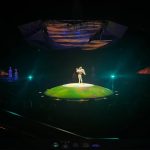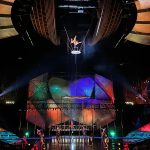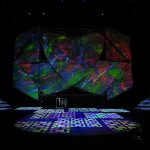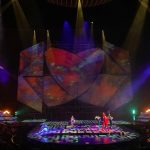“Mystère, which opened in December of 1993, may have been Cirque’s first permanent show in Las Vegas, although not the first Cirque show,” explains lighting designer Luc Lafortune, who recently re-lit the show. “That was Nouvelle Experience. It played for about 12 months or so, out at the Mirage which was then owned by Steve Wynn. I guess it was both Wynn and Cirque’s way of testing the market. The Big Top was out in the Mirage’s backlot. You couldn’t even see it from the strip, “ the LD adds. “The Dunes, The Sands, The Stardust, all of the old casinos were still around back then. The Mirage had opened just a few years back, and Treasure Island was little more than a whole in the ground.”
As Lafortune notes, “Mystère was not only Cirque’s first permanent show but also, for a lot of us, including Franco Dragone, it was our first show in a theatre of this magnitude. I had never lit a show in a theatre before, let alone one as unique. The theatre, not unlike the show, was custom built, to our specifications; lifts, rigging, thrust, catwalks, seats, carpeting, all of it. Back then, we even had a light bridge, just upstage of the proscenium, but that’s long gone,” he points out. “The stage is a mélange of both proscenium and thrust. The thrust was an homage to the Big Top. We also had lifts, four of them, including the entire thrust.”
“I don’t quite remember exactly, but I think that rehearsals lasted about two and a half months. Actually, it wasn’t rehearsals. It was “Creation.” Until then, we knew very little about the show. The scenery was for the most part complete, and we knew what the acts were going to be but that was about it. Costumes hadn’t been designed, music hadn’t been written, same thing for choreography, scenic moves hadn’t been plotted, and no one knew in what order the acts would proceed. We knew none of that, nor did we know how the show was going to open or what the Finale might look like,” says Lafortune. “It had always been like that at Cirque, particularly with Franco. It offered us great latitude but by the same token, it could be exceedingly unsettling. And still, despite all of this, I was expected to produce a light plot, which I did, although I kept it to a minimum…. I’d be curious to know how many of those initial fixtures made it past the 30 year mark. My guess, not many. Mind you, the show changed so much over the years, new acts, new clowns, new music and on and on.”
“One of the great advantages of working with Franco Dragone was that he never told me what to do. Most of what I got from him was either “yes,” or “I don’t like it. Find something else.” Guy Laliberté was very much the same. They never told us what to do but we had to be original. Typically, in the afternoon, rather than rehearse, we’d stage or as Franco put it, “Shake the stage”. Full crew. And in the evening, when everyone had gone home, I’d stay and we’d hang lights and try and come up with something. Again, a lot of latitude, tons of it but the process was exhausting, for everyone,” comments the LD.
“Over time, it became a lot easier and I looked forward to that time alone in the theatre. I’d play whatever music I liked, until all hours, and just create. But that wouldn’t happen for a few more years. Mystère was early in my career and I hadn’t done that many shows really. So for the most part, I was still winging it, designing it seems out of desperation more than anything else.”
“ScenoPlus I think was the original consultant. I remember I kept on asking for tons on lighting positions, not even knowing whether I was actually going to be hanging a fixture there. I think it was mostly insecurity. Then again, ScenoPlus weren’t accustomed to lighting circus acts. I was. The original design didn’t even have box booms, or a rail cove. We had to fight for those,” explains Lafortune. “Scenic designer Michel Crete was a purist and the idea of a box boom didn’t really appeal to him. Most of us didn’t even know what a box boom was. That was all Jeanette Farmer. I couldn’t have done it without her. The two of us were like a bull in a china shop. We were never careless, however we were relentless”.
Not too long ago, someone asked Lafortune what was his motivation for lighting Mystère: Where did the ideas come from and what was it that inspired you? “I think it may have been apprehension. I was just trying to make it thru the day, from one day to the next. When I designed Mystère, it was mostly by the skin of my teeth, and yet I think that sense of urgency somehow found it’s way to the stage. The lighting is vibrant, somewhat tense, at other times poetic, perhaps even surreal, almost reckless, whether it be the colors or the moving light effects,” he concludes.
Check out the following plot maps:
– Light Plot
– Floor Plot
– Basement Plot
Gear List:
180 ETC Fresnel V
153 ETC Spot V
43 Chauvet ColoRado 1 Solo
80 Chauvet ColoRado 2 Solo
24 Chauvet ColoRado 3 Solo
27 Robe Esprite
53 Robe Forte
2 MA Lighting grandMA 3 CRV consoles
3 MA Lighting grandMA3 NPU’s
1 MA Lighting grandMA2 on PC for relay control
10 Original ETC Sensor racks upgraded to Sensor 3 & 400 R20 relays
All new fiber network infrastructure with three new network racks and network ports and DMX output boxes in all new locations
ETC smart panel relay breaker panel
ETC Paradigm control for house lights and facility work lights
4 Robert Juliat OZ LED follow spots and 2 Alice models
{ SOURCE: Live Design }



